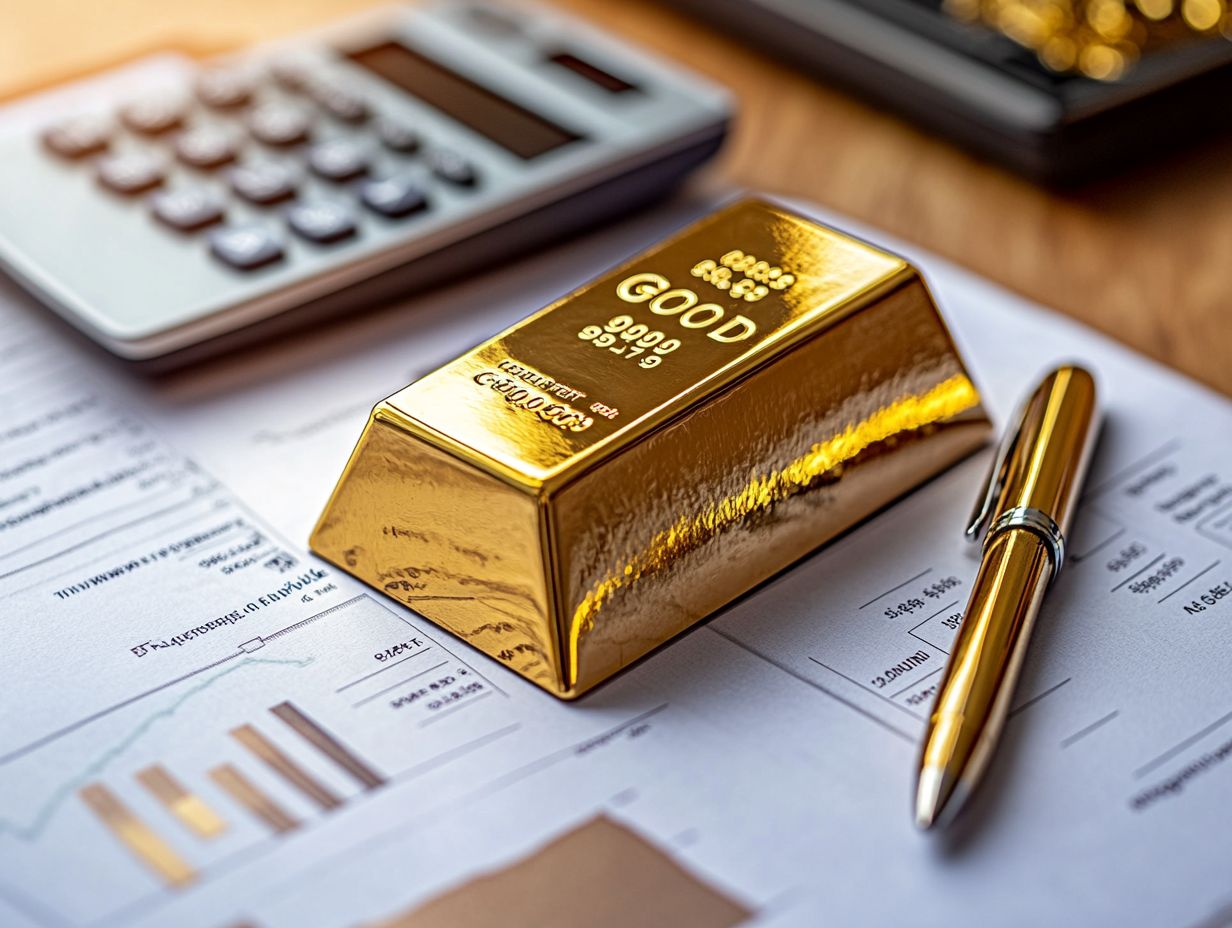Are ETFs a Good Way to Invest in Gold?
Exchange-Traded Funds (ETFs) have surged in popularity, presenting a flexible and accessible investment option for discerning investors like yourself. Among the various types, Gold ETFs particularly shine, providing a unique avenue to invest in precious metals without the complications of physical ownership.
This article delves into the mechanics of ETFs, with a spotlight on Gold ETFs their advantages, disadvantages, and crucial considerations you should weigh before making an investment. Whether you re a seasoned pro or simply exploring your options, you ll discover insights that can help steer your investment decisions.
Contents
Key Takeaways:

- Gold ETFs offer a convenient and cost-effective way to invest in gold without physically owning it.
- Investors can diversify their portfolio and benefit from the liquidity and transparency of ETFs in the gold market.
- Before investing in gold ETFs, consider market conditions, potential risks, and compare with other investment options to make an informed decision.
What are ETFs?
Exchange-Traded Funds (ETFs) represent an investment option traded on stock exchanges, much like individual stocks. They beautifully blend the diversification benefits of mutual funds with the liquidity inherent in stock markets.
By investing in ETFs, you can gain exposure to a diverse range of asset classes, including equities, commodities, and bonds, all while keeping trading costs low and enjoying a favorable expense ratio.
The surge in popularity of ETFs can be attributed to their low expense ratios, tax advantages, and the ease with which they can be traded. They attract modern investors looking to improve their investment strategies.
Benefits of Investing in ETFs
Investing in ETFs can open up a world of advantages for you, including enhanced liquidity and diversification across multiple asset classes. One standout benefit is their ability to provide exposure to gold and other commodities.
This exposure can effectively shield you from inflation while aligning with your financial goals and minimizing capital gains tax liabilities, which is the tax you pay on the profit from selling your assets. With lower expense ratios, ETFs present a cost-effective choice for today s savvy investors.
These investment vehicles grant you easy access to a wide array of markets, giving the power to both seasoned and novice investors alike to build a balanced portfolio without needing a significant capital outlay. ETFs are traded throughout the day on major exchanges, offering you unmatched flexibility in executing trades.
Plus, you can enjoy the transparency that ETFs offer, as they typically disclose their holdings daily, giving you a clear view of the actual assets you own. Importantly, ETFs often come with fewer tax implications than other funds, thanks to their unique structure, which frequently results in more favorable tax treatment.
With these amazing advantages, now is the time to consider ETFs! It s no surprise that they have gained popularity in recent years, attracting a broader audience eager for smart investment solutions.
Understanding Gold ETFs
Gold ETFs are specialized exchange-traded funds designed to give you exposure to gold without the hassle of physically holding the metal. This approach simplifies your investment process significantly.
Typically, these funds track the price of gold bullion, offering a convenient pathway into the gold market. This market is shaped by factors like global demand, market fluctuations, and geopolitical events.
By integrating Gold ETFs into your investment strategy, you can enhance both diversification and inflation protection within your portfolio.
How Gold ETFs Work

Gold ETFs function by tracking the price of gold. This allows you to buy and sell shares on stock exchanges, just like stocks. This mechanism boosts trading volume and liquidity.
The underlying assets of Gold ETFs typically comprise physical gold bullion or gold-related stocks. Therefore, the performance of these funds is closely tied to gold prices. Understanding how ETF transactions work is crucial for successfully navigating the gold market.
These exchange-traded funds provide a streamlined way to gain exposure to gold without the hassles of managing physical assets. When you trade shares of Gold ETFs, you are indirectly investing in the gold market, with a fund management team handling the acquisition and storage of gold on your behalf. For those looking to maximize their return, understanding how to sell your gold investments profitably can be crucial.
The pricing of these ETFs is influenced by various factors, such as political stability in the world, inflation rates, and currency fluctuations. These factors can introduce volatility into trading volume. Notably, demand for Gold ETFs often climbs during economic uncertainty, as investors typically gravitate toward safe-haven assets, amplifying their appeal in tumultuous times.
Types of Gold ETFs
There is a wealth of Gold ETFs available, ranging from those that invest directly in physical gold to those focused on gold mining companies and gold-related stocks. Each option presents its own set of advantages and risks.
Some Gold ETFs track the price of gold bullion, while others invest in gold mining companies and mutual funds dedicated to gold assets. Understanding the nuances between these choices is vital for aligning your investments with your financial goals.
If you seek direct exposure to gold, ETFs holding physical gold can be particularly appealing. They offer a straightforward way to capitalize on price movements in the gold market. Conversely, ETFs that invest in gold mining companies can bring extra leverage, often outperforming gold prices during bullish trends. To learn more about investing, check out this guide on how to invest in gold.
There are also Gold ETFs that blend both approaches, giving you diversified exposure. Before committing your funds, evaluate their risk profiles and potential returns to make informed decisions aligned with your investment strategy.
Pros and Cons of Investing in Gold ETFs
Investing in Gold ETFs is an exciting opportunity! However, it comes with both benefits and risks, making it essential to weigh both sides before incorporating these instruments into your investment portfolio.
On the plus side, you benefit from ease of trading, tax efficiencies, and the chance to diversify into the gold market. This can serve as a hedge against inflation.
However, it’s important to recognize the downsides, such as potential price fluctuations and risks associated with market volatility that could affect your returns. A thoughtful approach to risk management is necessary as you navigate your investment strategy.
Advantages of Gold ETFs
Investing in Gold ETFs presents numerous advantages, including enhanced diversification, increased liquidity, and attractive tax benefits. These factors make Gold ETFs a compelling choice for today s savvy investors aiming to optimize their investment strategies.
With these ETFs, you gain effortless access to the gold market, sidestepping the headaches of secure storage associated with physical gold. If you’re considering investing in gold directly, it’s important to know what the best places to buy physical gold are. They can also act as a reliable hedge against inflation and economic uncertainty.
Incorporating Gold ETFs into your diversified portfolio can be a strategic move, helping to mitigate risks while potentially boosting your overall returns. To further safeguard your assets, consider learning how to protect your gold investments. Their high liquidity allows you to easily buy or sell shares at market prices, giving you flexibility during market fluctuations.
The tax treatment of profits from Gold ETFs is often more favorable than that of traditional physical gold investments, enhancing your overall yield. For those eager to reap the benefits of precious metals while keeping their investment approach streamlined, how to use gold to diversify your portfolio provides a robust and sophisticated solution.
Disadvantages of Gold ETFs

Gold ETFs have many advantages, but they also come with some drawbacks. First, you may face market fluctuations and fund management fees that could affect your returns.
As an investor, you need to navigate risks related to price movements and the overall performance of the gold market. External factors can influence these elements, making it essential to grasp these risks before allocating your funds.
The volatility of gold prices can swing dramatically due to global economic conditions, political uncertainty, and shifts in demand. Additionally, the costs associated with Gold ETFs can eat into your profits. These management fees are often overlooked by novice investors, and they can accumulate, ultimately reducing your investment gains.
The risks related to liquidity can also present challenges. During market downturns, selling may force you into unfavorable pricing. Understanding these dynamics is crucial if you want to successfully diversify your portfolio with Gold ETFs!
Factors to Consider Before Investing in Gold ETFs
Before investing in Gold ETFs, consider several important factors. Examine current market conditions, ensure the investment options align with your financial goals, and adjust for risk within your overall strategy.
Analyzing historical performance, understanding gold demand, and evaluating your financial objectives are critical steps to ensure that Gold ETFs fit well with your investment portfolio.
Market Conditions and Risks
Market conditions significantly impact the performance of Gold ETFs. Price fluctuations and inflation can affect your overall returns. Understanding these market dynamics along with geopolitical factors (the influence of global politics on markets) and economic indicators is essential for making informed investment decisions.
Fluctuations in interest rates, currency strength, and global demand can cause volatility, leading to notable price swings in gold assets. While inflationary pressures often drive investors toward gold as a hedge, these conditions might also affect your investments’ purchasing power over time.
As you navigate the world of Gold ETFs, stay alert to these interconnected elements. Understanding how changes in market feelings and government policies can impact your investments will empower you to make smarter choices in this complex landscape.
Comparison with Other Investment Options
When considering Gold ETFs, it s crucial to compare them with other investment options like mutual funds, equity investments, and sovereign gold bonds. Each option has unique characteristics, including liquidity, risk profiles, and potential returns, all of which can significantly influence your decision-making process.
Gold ETFs excel due to their simplicity and real-time trading capabilities, allowing you to buy and sell shares easily throughout the trading day. If you’re considering investing in gold, knowing when to buy gold is crucial. In contrast, mutual funds may come with longer settlement times and management fees that can diminish your returns.
Equity investments inherently carry higher volatility, presenting opportunities for substantial gains alongside the risk of significant losses. On the other hand, sovereign gold bonds provide fixed interest returns and capital appreciation, but they don t offer the immediate liquidity that ETFs do.
This combination of factors makes it essential for you to carefully assess your financial goals and risk appetite before diving into any particular investment avenue.
Frequently Asked Questions

Are ETFs a Good Way to Invest in Gold?
Yes, ETFs (Exchange-Traded Funds) can be a good way to invest in gold for various reasons. They offer a convenient and cost-effective way to gain exposure to the price of gold without physically owning it.
Explore your options further, and don t hesitate to consult a financial advisor to make the best decisions for your investment strategy!
What are ETFs?
ETFs, or Exchange-Traded Funds, are investment funds traded on an exchange. They behave like stocks and often track an index or commodity, like gold.
How do ETFs work in relation to gold?
Gold ETFs usually hold physical gold or contracts tied to gold prices. This means their value changes as gold prices fluctuate.
What are the benefits of investing in gold ETFs?
Gold ETFs can provide diversification and liquidity. You can invest in fractional shares, giving you flexibility and making it more affordable.
Are there any downsides to investing in gold ETFs?
Investing in gold ETFs comes with risks. Market volatility, management fees, and tracking errors can affect your investment.
What should I consider before investing in gold ETFs?
Research the fund s objectives, fees, and track record before investing. Consulting with a financial advisor can help ensure gold ETFs align with your goals.















